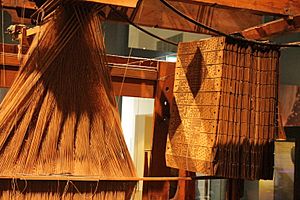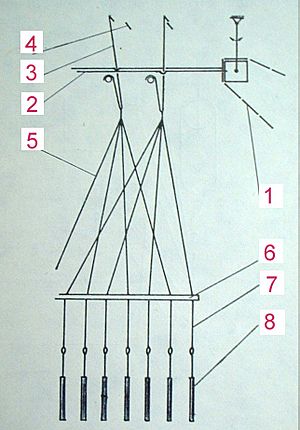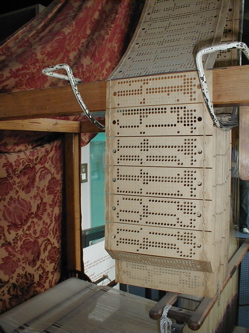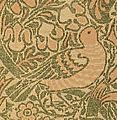Jacquard machine facts for kids

The Jacquard machine (French: [ʒakaʁ]) is a special device added to a loom. It makes it much easier to create textiles with tricky patterns like brocade or damask. When a loom has a Jacquard machine, it's called a Jacquard loom.
Joseph Marie Jacquard patented this machine in 1804. But it was based on earlier ideas from other French inventors like Basile Bouchon (1725), Jean Baptiste Falcon (1728), and Jacques Vaucanson (1740). The machine worked using a "chain of cards." These were many punched cards linked together in a long line. Each card had rows of holes and stood for one row of the fabric's design.
The Jacquard process and the machine are named after their inventor. This invention is one of the most important in weaving. It allowed for many different complex patterns to be made automatically. The name "Jacquard" refers to the special control system that adds patterns, not a specific type of loom. This process can also be used for patterned knitwear, like jersey fabrics.
Using changeable punched cards to control a series of actions was a big step in the history of computing hardware. It even inspired Charles Babbage's Analytical Engine, an early computer design.
Contents
History of the Jacquard Loom
Before the Jacquard machine, complex designs were made on a drawloom. A second person, called a "draw boy," had to manually choose which threads to pull up. This work was very slow and took a lot of effort. Also, the patterns couldn't be too complicated.
The first idea for a Jacquard-like loom came in the late 1400s. An Italian weaver named Jean le Calabrais from Calabria created it. He was invited to Lyon by Louis XI. He introduced a new machine that could work with yarns faster and more accurately. Over the years, looms kept getting better.
In 1725, Basile Bouchon improved the draw loom. He used a perforated (holed) paper band. This long paper roll was punched by hand. Each section of holes stood for one row of the pattern. The length of the roll depended on how many rows were in the pattern. The Jacquard machine later grew from this idea.
Joseph Marie Jacquard saw that a machine could be made to create very detailed patterns. He likely combined ideas from other inventors, but he also added his own new ideas. His machine was similar to Vaucanson's. But Jacquard used Jean-Baptiste Falcon's individual pasteboard cards and his square prism (or "cylinder"). Jacquard made holes on all four sides of the prism, replacing Vaucanson's round "barrel." Jacquard's machine had eight rows of needles and uprights, while Vaucanson's had only two. This change allowed Jacquard to make much more complex patterns.
One of the main benefits of Jacquard's machine was that it could draw the pattern on every single thread pass. Older machines usually drew the pattern only every four passes. This meant Jacquard's machine could make fabrics with much clearer and sharper designs.
Jacquard's invention greatly influenced Charles Babbage. Because of this, some people see Jacquard as a very early pioneer of modern computing technology.
How the Jacquard Machine Works
Imagine a long chain of cards (1) that moves over a square box. With each turn, a new card comes into place. This card represents one row (or "pick") of the fabric design. The box swings and presses against control rods (2).
If there's a hole in the card, the rod passes through it and doesn't move. If there's no hole, the rod is pushed to the left. Each rod is connected to a hook (3). When a rod is pushed, its hook moves out of the way. If a rod isn't pushed, its hook stays in place.
Then, a beam (4) rises under the hooks. Only the hooks that stayed in place are lifted by the beam. The hooks that moved out of the way are not lifted. Each hook can have many cords (5) attached. These cords go through a guide (6) and are connected to a heddle (7) and a weight (8). The heddles lift the warp threads. This creates an opening called a "shed." The shuttle, carrying the weft thread, then passes through this shed.
For example, a loom with a 400-hook head might have four threads connected to each hook. This could create a fabric that is 1600 warp threads wide, with four repeats of the pattern across it.
The term "Jacquard loom" isn't quite exact. It's the "Jacquard head" that can be added to many different dobby looms. This addition allows the weaving machine to create the detailed patterns seen in Jacquard fabrics.
Jacquard looms are common in the textile industry, but they are not as widespread as dobby looms. Dobby looms are usually faster and cheaper to run. However, dobby looms cannot make as many different patterns from one set of warp threads. Modern Jacquard machines are controlled by computers instead of punched cards. They can have thousands of hooks.
Setting up a Jacquard machine with new threads is a lot of work. So, many looms are threaded only once. New warp threads are then tied to the old ones using a special knotting robot. Even for a small loom with only a few thousand warp ends, re-threading can take days.
Mechanical Jacquard Machines
The first Jacquard machines were mechanical. The fabric design was stored on a series of punched cards linked together in a chain. These early Jacquard machines were often small. They could only control a small number of warp threads independently. This meant that patterns had to be repeated many times across the width of the fabric. Larger machines, or using several machines, allowed for more control. This meant fewer repeats and larger designs could be woven.
A factory chooses its looms and pattern-making machines based on what it needs to produce. Generally, the more control needed over the warp threads, the more expensive the machine. So, it's not cost-effective to buy Jacquard machines if a simpler dobby mechanism will do the job.
Besides the initial cost, Jacquard machines are also more expensive to keep running. They are complex and need skilled workers. A costly design system is also needed to prepare the patterns for the loom, and sometimes a card-cutting machine too. Weaving with Jacquard machines can also be more expensive because they are more likely to have errors than dobby or cam machines. Also, the looms don't run as fast. There's more "down-time" because it takes time to change the chain of cards when a design changes. For these reasons, it's best to weave large amounts of fabric when using mechanical Jacquards.
Electronic Jacquard Machines
In 1855, a French person tried to adapt the Jacquard machine to work with electro-magnets. People were interested, but the tests didn't work well, and the idea was soon forgotten.
Then, in 1983, Bonas Textile Machinery NV launched the first successful electronic Jacquard machine at a big textile exhibition in Milan. At first, these machines were small. But modern technology has greatly increased their power. Now, a single electronic Jacquard machine can control more than 10,000 warp threads individually. This means there's no need for repeats or symmetrical designs. It allows for almost endless design possibilities.
Computer-controlled machines greatly reduce the time it takes to change designs. This means factories can make smaller batches of fabric. However, electronic Jacquards are expensive. They might not be needed in a factory that weaves large amounts of fabric or simpler designs. The very large machines that control each thread individually are extremely costly. They are only worth it when a factory needs great flexibility or has very special design needs. For example, they are perfect for the few remaining linen Jacquard weavers in Europe and the West. Most large-scale fabric weaving has moved to places where costs are lower.
Jacquard weaving is used for many different products. These include linen damask tablecloths, Jacquard clothing fabrics, and damask bed linen. Jacquard weaving uses all kinds of fibers and mixed fibers. It creates fabrics for many different uses. It can also make fabrics with a Matelassé or brocade pattern. Researchers are also working to use Jacquard weaving to create layered and shaped parts for structures made from composite materials.
The Woven Silk Prayer Book
One amazing example of what a Jacquard machine can do is a prayer book woven entirely from silk. The book's title is Livre de Prières. Tissé d'après les enluminures des manuscrits du XIVe au XVIe siècle. All 58 pages of this prayer book were made of silk, woven using a Jacquard machine. It used black and gray threads. The pages have detailed borders with text and pictures of saints.
It's thought that between 200,000 and 500,000 punched cards were needed to create the pages. The fabric had 160 threads per centimeter (400 threads per inch).
This special book was made in 1886 and 1887 in Lyon, France. It was shown to the public at the 1889 Exposition Universelle (World's Fair). R. P. J. Hervier designed it, J. A. Henry wove it, and A. Roux published it. It took two years and almost 50 tries to get it just right. About 50 or 60 copies of the book were made.
Importance in Computing
The Jacquard machine used changeable punched cards to control a series of actions. This is seen as a very important step in the history of computing hardware. The idea of changing the loom's pattern simply by changing cards was a key concept. It led to the development of computer programming and how data is entered into computers.
Charles Babbage knew about Jacquard machines. He planned to use cards to store programs for his Analytical Engine, an early mechanical computer. Later, in the late 1800s, Herman Hollerith took the idea of using punched cards to store information even further. He created a punched card tabulating machine. He used it to input data for the 1890 U.S. Census.
A large industry for processing data using punched cards grew in the first half of the 1900s. It was mainly led by International Business Machine (IBM) with its unit record equipment. These cards were used for data, while programming was done using plugboards.
Some early computers, like the 1944 IBM Automatic Sequence Controlled Calculator (Harvard Mark I), got their program instructions from a paper tape with holes. This was similar to Jacquard's chain of cards. Later computers ran programs from faster memory. However, cards were still commonly used to load programs into memory. Punched cards were used in computing until the mid-1980s.
Images for kids
-
Punched cards being used in a Jacquard loom at the German Museum of Technology, Berlin
-
Weaving on a Jacquard loom with a flying shuttle at the Textile Department of the Strzemiński Academy of Fine Arts in Łódź, Poland.
-
A detail of Dove and Rose, a Jacquard-woven silk and wool double cloth furnishing textile, designed by William Morris
-
Punched paper tape used to give instructions to the 1944 Harvard Mark I computer
See also
 In Spanish: Telar de Jacquard para niños
In Spanish: Telar de Jacquard para niños
- Thomas Ferguson & Co Ltd, a Jacquard weaver






















